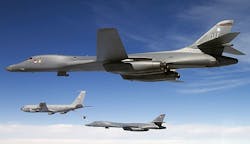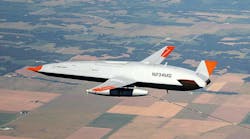Officials of the Air Force Materiel Command at Hanscom Air Force Base, Mass., issued a solicitation Friday (BAA-HNAK-2017-0001) for the three-year VLF)/LF Communications Technologies Research project, which seeks to identify promising technologies for new VLF receiver systems.
VLF and LF communications are at radio frequencies between 3 and 300 kHz -- lower than the medium-frequency commercial AM radio band -- and are for secure military communications that help control land- aircraft- and sea-based nuclear missile forces. VLF/LF bands also are for radio navigation and timing systems.
Among the benefits of VLF and LF RF communications is its limited ability to propagate through water to send messages to submerged nuclear missile submarines. Military Take Charge and Move Out (TACAMO) aircraft, for example, use VLF and LF trailing wire antennas to send messages to missile submarines.
Related: Air Force asks industry for ideas on reinvigorating nuclear weapons command and control
The VLF/LF Communications Technologies Research project will determine if there have been technology advances for future common VLF receivers, antennas, and waveforms that could be used aboard U.S. aircraft like the B-52, E-4B, Navy E-6B, B-2, Long Range Strike Bomber, tankers, and intercontinental ballistic missile (ICBM) control centers.
Air Force officials say they're looking for new technologies that could be potential solutions to urgent problems in VLF/LF communications technologies. The goal is to discover technologies for VLF receivers, VLF antennas, VLF propagation and waveform modes, and VLF legacy software modifications.
Air Force researchers will issue separate calls for industry white papers, which could lead to invitations for formal proposals. Each Call will identify focus areas related to VLF technologies for near-worldwide RF coverage for nuclear command and control.
In each of the four VLF receiver, antennas, waveforms, and software areas, Air Force experts are interested in capacity, feasibility, and technology readiness levels, with performance improvements anticipated in range, time of receipt, interoperability, and cost reductions through platform commonality.
Related: Nuclear ballistic missile command and control technology still a prime military concern
Overall funding over the three-year program will be about $4.4 million, with $1 million this year, and $3.4 million in 2018. Air Force officials may host industry briefings in the future at the MITRE Corp. in Burlington, Mass.
For more information on these possible briefings contact the Air Force's Daira Rodriguez by email at [email protected] or by phone at 781-271-2006. Also contact Filomena Gomez by email at [email protected], or by phone at 781-271-5067.
More information is online at https://www.fbo.gov/spg/USAF/AFMC/ESC/BAA-HNAK-2017-0001/listing.html.
Learn more: search the Aerospace & Defense Buyer's Guide for companies, new products, press releases, and videos



